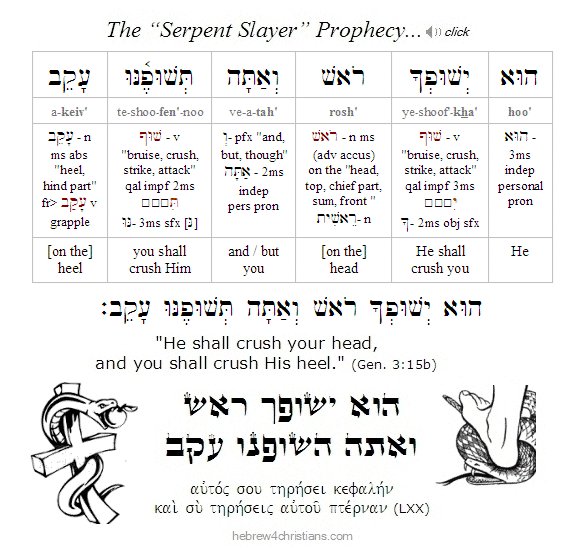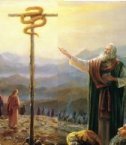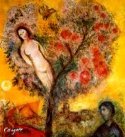|
THE VERY FIRST PROPHECY OF THE TORAH concerns the promise of the coming "Seed of the woman" who would vanquish the serpent (nachash) that had originally tempted and deceived Eve (Gen. 3:15). This prophecy is sometimes called the proto-euangelion ("first gospel"), since it is the starting point of all subsequent prophecy and redemptive history revealed in the Scriptures. Indeed, since the mystery of the Incarnation of God the Son (the "Son of Man") is foreshadowed here, this prophecy is linked to the original woman, Eve. Just as Eve became a carrier of the corruption of human nature by heeding the voice of the tempter, so she would be the carrier of God Himself for the deliverance of mankind through the advent of the Redeemer. In the tragic aftermath of the transgression of the first man and woman, then, God first announced His unfailing redemptive love for the human race that would culminate in the birth, sacrifice, and resurrection of Yeshua our Savior and Deliverer - "born of a woman, born under the law" (Gal. 4:4).
Our restoration begins with God's love and passion. God's first question to Adam after he broke covenant was: "Where (אַיֶּכָּה) are you?" - the voice of a loving Father in search of his son (Gen. 3:9). Of course God knew exactly how his son was attempting to hide, though He almost acted as if He was unwilling to believe that he would betray his love by disobeying His commandment. Therefore God's poignant question was directed to Adam's heart: "Oh my son, how did you get to this place?" God was giving Adam an opportunity to turn back to Him, to confess the sin, to undergo teshuvah, to become reconciled... This is the necessary prelude to any honest relationship with God.
Recall that the original promise of the coming Savior was given within the context of the curse and judgment upon Satan: "I will put enmity between you and the woman, and between your seed and her seed; he shall crush your head, and you shall crush his heel" (Gen. 3:15). That God's promise was first directed to Satan is surely by design, since he "left his first estate" by becoming the "monster in the garden" and was therefore primarily responsible for the transgression of Adam and Eve in the first place (Ezek. 28:13-15,19). The promise delivered to Satan was therefore one of coming retribution and divine judgment: Evil would not have the last word in the matter of mankind, and therefore Satan's schemes would be avenged by God in the fullness of time (Gal. 4:4-5). Notice, however, that Adam and Eve were not yet judged for their sin when the LORD God gave the promise of the coming of the Redeemer. Before a word of judgment was directed toward them, God's love and light was already revealed. Indeed, immediately after their judgment was pronounced, "the LORD God made tunics of skin for Adam and his wife and clothed them" (Gen. 3:21) - a clear picture of being compassionately "robed in righteousness" imparted by an innocent sacrifice. The very first sacrifice recorded in the Torah - performed by God Himself - prefigured the coming redemption by the "seed of the woman" who would die as a substitutionary sacrifice for their sins, and therefore Yeshua is rightly called "the Lamb slain from the foundation (or beginning) of the world" (Rev. 13:8). This further explains why Eve's son (Abel) offered a blood sacrifice that was accepted by the LORD, whereas Cain's offering the "fruit of the earth" was rejected.
The first prophecy of Torah therefore describes - in the most succinct form - the coming of the Savior and the great conflict of the ages. First, God declares that He would put enmity (אֵיבָה) between Satan and the woman. This enmity, or "hostile hatred," was based on the memory of Eve's misguided trust she evidenced in the garden. When Eve first sympathetically listened to the lies of the nachash (serpent), she immediately began her descent into exile and became a temptress herself. Her first step toward sin was a gullibility or openness that ultimately resulted in a lack of trust of God (which is part of the reason why we must be saved by trusting, as a "like-for-like" reversal of the original sin). At the very dawn of human history, then, we see that "truth" (אֱמֶת) apart from God (א) leads to death (מֵת). Eve was deceived because of Satan, but Adam deliberately chose to disobey God (2 Cor. 11:3; 1 Tim 2:14). In response to her teshuvah (repentance), God blessed Eve before He judged her by imparting to her a God-given hatred for Satan and his lies, as well as the promise that she would take part in the birth of the Savior of mankind. The first promise of the gospel, then, focused on the woman and her role in the coming redemption. Notice that Adam later renamed his wife Eve (i.e., Chavah: חַוָּה, the "mother of life") as an expression of his faith that the promised seed would come through her.
וְאֵיבָה אָשִׁית בֵּינְךָ וּבֵין הָאִשָּׁה
וּבֵין זַרְעֲךָ וּבֵין זַרְעָהּ
הוּא יְשׁוּפְךָ רֹאשׁ
וְאַתָּה תְּשׁוּפֶנּוּ עָקֵב
ve·ey·vah a·sheet bey·ne·kha oo·veyn ha·ee·shah
oo-veyn zar·a'·kha oo-veyn zar-ah
hoo ye·shoof-kha rosh
ve·a·tah te·shoo·fen'·noo a·keiv

I will put enmity between you and the woman, and between your offspring and her offspring; he shall bruise your head, and you shall bruise his heel."
(Gen. 3:15)

It is likely that Eve initially believed that her firstborn son Cain (קַיִן) was the promised Seed himself. After all, the miracle of birth surely came as a great shock to her, and Eve's faith in God's promise that through her seed would come the deliverer was doubtlessly upon her heart at this time. When Eve called her son "Cain" (wordplay from the verb kana (קָנָה), "to get"), she was expressing her faith in God's promise: קָנִיתִי אִישׁ אֶת־יהוה / kaniti ish et-Adonai, "I have gotten a man - namely, the LORD" (Gen. 4:1). Eve's faith was obscured by the translators, however, who rendered the Hebrew as "I have gotten a man with the help of the LORD" (i.e., they inserted the idea of "help" and translated the particle et (את) as "with" rather than as the direct object marker for the verb). The ancient Jewish targums, however, agree with the original Hebrew. For example, Targum Yonatan reads: "I have gotten a man - the Angel of YHVH." Surely Eve, the first mother of humanity, was endowed with great wisdom from God, especially after she turned to Him in repentance after her disobedience. The straightforward reading of her words, then, expressed her hope that the LORD Himself would be made a man....
Despite her hope that Cain was none other than the God-Man and promised Deliverer, Eve's hopes were dashed when it became clear that her son was of the seed of Satan (1 John 3:12). His younger brother Abel (הֶבֶל) was a shepherd who evidenced faith in the promise of the coming redeemer by offering blood sacrifice (Gen. 4:3-5). Abel was persecuted and finally murdered by his brother Cain "because his own deeds were evil and his brother's righteous." Their spiritual conflict is indicative of the ongoing warfare between the "sons of darkness" and the "sons of light."
The murder of Abel necessitated that the coming seed would descend through another child, and therefore the Torah describes the birth of Seth (שֵׁת, lit. "appointed"), the third son of Adam and Eve. The Scriptures further state that it was the descendants of Seth who "began to call upon the Name of the LORD" (לִקְרא בְּשֵׁם יהוה), indicating that they had faith in God (אֱלהִים) as the Compassionate Covenant Keeper (יהוה) who would redeem humanity by means of the coming seed. Seth called his firstborn son Enosh ("man"), perhaps in the hope that his child would be the promised Savior (interestingly, bar enosh (בַּר אֱנָשׁ), or "Son of Man," is the name for the Savior (Dan 7:13).
The Torah's statement, "I will put enmity between your (Satan's) seed and her seed" is somewhat ambiguous, however. The Hebrew word "seed" (i.e., zera: זֶרַע) is singular in form though it can refer to a collective group or kind (e.g., "offspring" in Isa. 1:4; Gal. 3:16). The "seed of the woman" therefore refers primarily to the promised Seed (i.e., Savior) to come but also to those descendants of Eve who would share her faith in God's redemption (i.e., the godly line beginning with Abel/Seth, Enosh...). This is consistent with most prophetic utterances found in Scripture, which often foretell of temporal events that signify deeper spiritual truths. On the other hand, the "seed of the serpent" refers collectively to those descendants who are the spiritual progeny of the devil (i.e., the ungodly line beginning with Cain, Canaan... (John 8:44; Matt. 3:7; 13:38) as well as to the coming of the future Anti-Christ, or "Messiah of Evil" that will be revealed at the End of Days. The seed of the serpent therefore refers to corrupted and carnal human nature, whereas the seed of the woman refers to those who are regenerated by faith in God's salvation.... Understood in the collective sense, the prophecy implies perpetual warfare between the descendants of Eve who shared her teshuvah (called the "children of light") and the descendants of Satan who refused it (called the "children of darkness"). The ongoing enmity between these "two seeds" foretells the "tale of two kingdoms," the Kingdom of God (מַלְכוּת אֱלהִים) and the kingdom of the devil (John 8:34-36). The Apostles likewise spoke of "children of darkness" and "children of light" (Eph. 5:8; Col. 1:13, 1 Thess. 5:5, etc.). The children of light are called to be am kadosh - a holy people - separate from the evil engendered by the fallen world and its forces, just as the very first creative expression of God was the separation of light from darkness (Gen. 1:3-4). The children of light "hate evil and love the good," and conversely, the children of darkness "hate the good and love evil" (Psalm 34:21, Prov. 8:13, Amos 5:15, John 3:20-21). Politically speaking, St. Augustine described the cosmic conflict as one between the "City of Man" and the "City of God."
Ultimately, however, the promise points to the final outcome of the battle between the coming Savior (the Seed of the woman) and the devil himself: "... he (i.e., the Savior/Messiah) will crush your head (ראשׁ), and you (i.e., the serpent/Satan) will crush his heel (עָקֵב)." The crushing of Satan's head refers to the destruction of his usurped dominion over mankind. Yeshua, the "Son of Man" and "Second Adam," landed a mortal blow directly to the head of the evil one himself, and through His sacrifice has "destroyed the works of the devil" (Col. 2:15, 1 John 3:8). The "crushing of the heel of the Savior" referred to Yeshua's suffering by being rejected and crucified for our sins. "But when the fullness of time had come, God sent forth his Son, born of woman, born under the law, to redeem those who were under the law, so that we might receive adoption as sons" (Gal. 4:4-5).

As I mentioned in another place, "God creates the cure before the plague." Just as God created mankind only after He created the pathway of repentance (i.e., Yeshua is described as the "Lamb slain from the foundation of the world": 1 Pet. 1:20, Eph. 1:4, Rev. 13:8, 17:8), so the purification from death and the nullification of the curse was likewise foreseen and provided by the Cross of the Messiah. Yeshua is the antidote to the venom delivered through the serpent's bite (John 3:14-15). "For as in Adam all die, so also in Messiah shall all be made alive" (1 Cor. 15:22). The "new seed" of life given to us in Yeshua makes us into a "new creation" (בְּרִיאָה חֲדָשָׁה) that fully restores the defaced image of God within us: "Just as we have borne the image of the man of dust, we shall also bear the image of the man of heaven" (1 Cor. 15:49).
God's redeeming love was present from the beginning. The midrash states that Adam was created from the "dust of the Temple." After Adam's transgression, the Tree of Life was "removed from reach" and guarded by cherubim until the blood that spoke a "better thing than the blood of Abel" was offered for the redemption of mankind (Heb. 12:24). This "better thing" was prefigured in many ways in Scripture: through the martyrdom of Abel, through the Akedah of Isaac, through the blood of the lamb that delivered Israel from the angel of death, through the blood sprinkled upon the kapporet ("mercy seat") of the Ark of the Covenant, through the sacrifice of the Red Heifer, and most especially through the sacrificial death of Yeshua upon the Cross at Moriah.... Those who trust in the sacrifice and victorious resurrection of the Messiah are given access to eat of the Tree of Life in the Paradise of God (Rev. 2:7; 22:14).
Addendum: As has been noted by various scholars, Genesis 3:15 has historically been understood as a Messianic prophecy, not just by the early church fathers, but by the Jewish sages as well. The Septuagint (LXX) translated the verse with Messianic overtones, and the Targum of Jonathan and the Jerusalem Targum both speak of "a remedy for the heel in the days of the king Messiah." Likewise the Apostle Paul regarded the victory of the gospel as a fulfillment of the promise made to Adam and Eve in the garden of Eden (Rom. 16:20). From the very beginning, then, we see that the promise of the coming Savior is mingled with victory and suffering, of glory and humiliation. This "dual aspect" of the Messiah is present in most of the prophecies of Scripture concerning our Savior.
|




